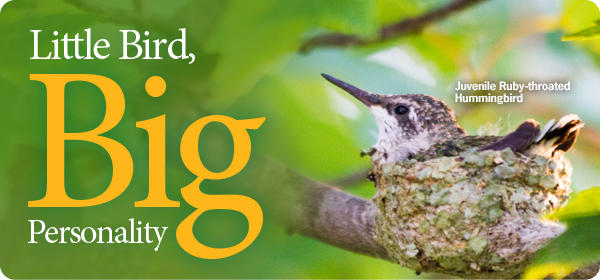We LOVE Hummingbirds!

So Much to Know About Hummingbirds!
Ruby-throated Hummingbirds will begin to arrive in Ottawa early May! We recommend hanging your hummingbird feeder in early May (we often say they are here for Mother's Day).
The Ruby-throated Hummingbird is the only species of hummingbirds that visit us here in Ottawa. They migrate to Central America for the winter months and return to their more northern breeding grounds in the Spring.
Are you excited for the hummingbird activity to ramp up in your yard? They are active at feeders and flowers as well as sourcing protein from spiders and other insects. Keep your feeders full and clean to watch these little jewels.
To make your own hummingbird nectar, mix four parts water to one part white table sugar. It's not necessary to boil the water, but you may find that using warmer water helps to dissolve the sugar more quickly. Change the nectar and wash your feeder in hot water every few days (more often in hot weather). Do not use red food dye or any other type of sugar/sweetener (only use white table sugar).
Hummingbirds are indeed small, weighing 1/10th of an ounce; about the weight of a penny. They also lay the world’s smallest bird egg; about the size of a blueberry.
For such a little bird, hummingbirds can be very feisty and aggressive when defending their territories; which includes nectar feeders. Multiple feeders, spread throughout your yard, will encourage more hummingbirds to visit and keep bullies at bay. The more feeders you offer and the more spread out they are, the more difficult it is for a protective hummingbird to defend all the feeders. Others, like females or even juveniles, will be able to eat more often, perhaps staying longer to feed or rest at feeders.
Speaking of feeders, these little birds have big appetites. Hummingbirds eat about every ten minutes and their diet is not made up entirely of nectar. They spend more than 25% of their time foraging for small spiders and insects to obtain essential amino acids and other nutrients.
Hummingbirds use their bill and not their tongue to catch prey while they forage near the ground and in trees. They love spiders and spider eggs and keep an eye out for small flying insects like midges, fruit flies and gnats. They also check leaves and branches for leaf hoppers, aphids and even the occasional small caterpillar.
Our little hummingbirds are deceptively big on speed. They often seem to explode away from a feeder like a dragster. They typically fly at 50-70 km/h, but can fly up to 96 km/h. They can even hover and are the only birds able to regularly fly backwards and even occasionally upside down. They can do this because of an extremely mobile shoulder joint.
Be a seasonally savvy bird feeder by installing multiple hummingbird nectar feeders around your yard to draw in these little birds with the big personalities.

